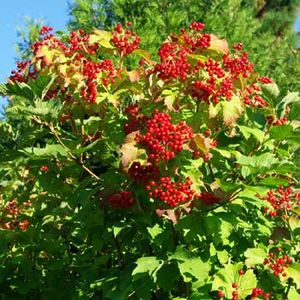Cramp Bark
Other Names: Bois à Quenouille, Boule de Neige, Common Guelder-Rose, Crampbark, Cranberry Bush, European Cranberry-Bush, Guelder Rose, Guelder-Rose, High Bush Cranberry, High-bush Cranberry, Obier, Rose de Gueldre, Snowball Bush, Viburno Opulus, Viburnum opulus, Viorne Aquatique, Viorne Aubier, Viorne Obier, Viorne Trilobée.
Cramp bark is a plant that grows in North America. Historically, Native Americans used cramp bark as medicine for reducing swollen glands and treating fluid retention, mumps, and eye disorders. They also smoked cramp bark as a substitute for tobacco. These days, the bark and root bark of this plant are still used to make medicine. In addition, the berries of the viburnum plant are sometimes consumed as food.
Special Precautions of Cramp Bark
- Don’t confuse cramp bark with Black Haw (Vibernum prunifolium), which is sometimes referred to as cramp bark.
- There's some concern that taking viburnum in combination with blood pressure medication or antibiotics may have harmful effects.
Benefits and uses of Cramp Bark are
Viburnum bark contains several compounds found to enhance health, including ellagic acid (a chemical with antioxidant benefits). The berries of the viburnum plant also contain a number of antioxidants, including vitamin C. Cramp bark is an antispasmodic and anti-inflammatory that restores balance in voluntary and involuntary muscle spasms. Chemicals in cramp bark seem to decrease muscle spasms. These chemicals might also lower blood pressure and decrease heart rate.
uses :
- Cramps.
- Muscle spasms : In studies conducted in the 1960s and 1970s, scientists found that certain compounds present in viburnum bark may help suppress muscle spasms and reduce muscle tension. Although viburnum bark is commonly used for conditions involving muscle spasms and muscle tension (such as menstrual cramps and low back pain), there is a lack of more recent research on viburnum bark's effectiveness against such conditions.
- Menstrual cramps.
- Cramps during pregnancy.
- Cancer : While recent research on viburnum bark is lacking, there's some evidence that the fruit of the viburnum plant may offer certain health benefits. For example, a preliminary study published in Toxicology and Industrial Health in 2012 found that the juice of viburnum fruit may help fight colon cancer.
- Hysteria.
- Nervous disorders.
- Use as a kidney stimulant in urinary conditions which involve pain or spasms.
- Stomach Ulcers : a 2006 study on rats (published in the Journal of Physiology and Pharmacology) determined that antioxidants found in viburnum fruit may help protect against the gastrointestinal damage associated with ulcer development.
